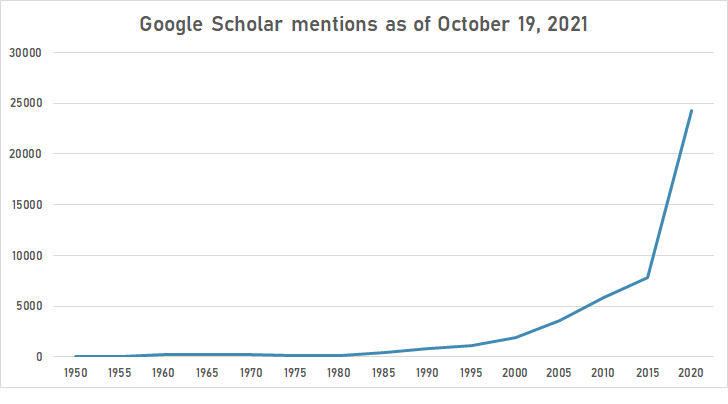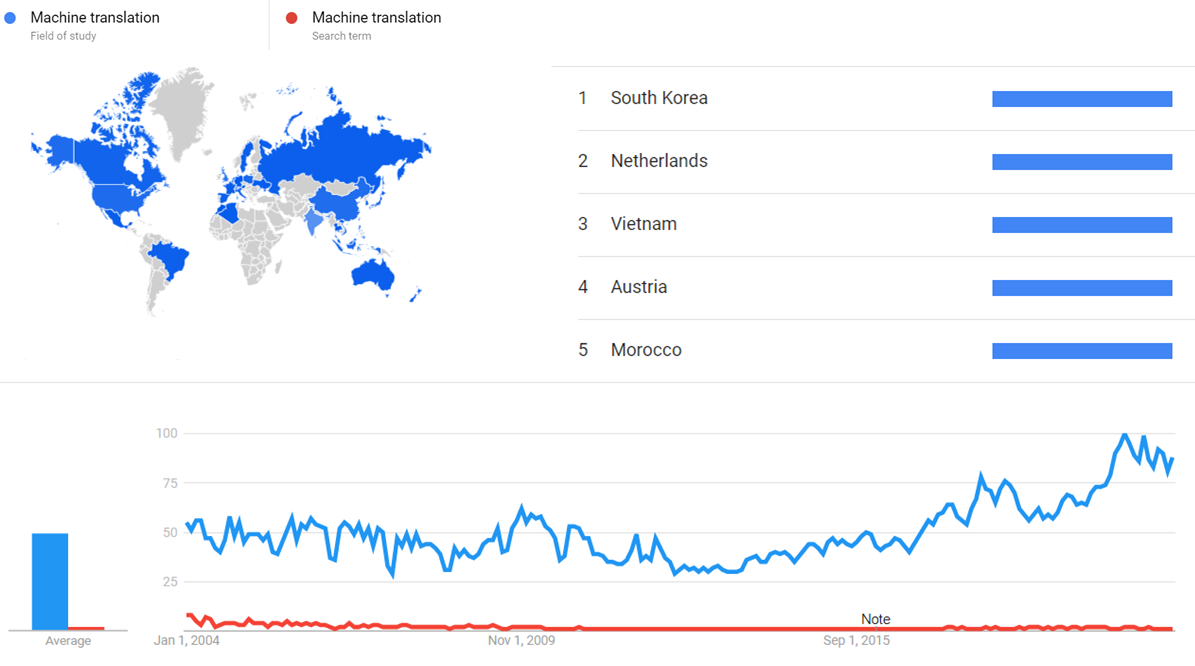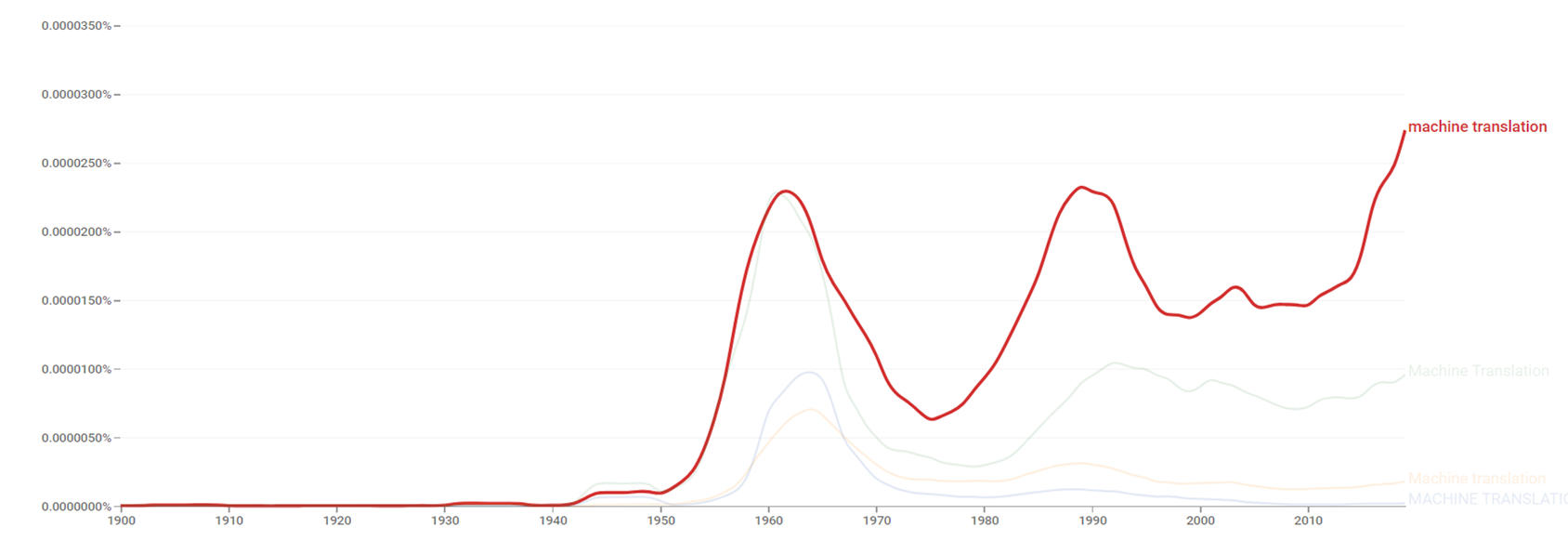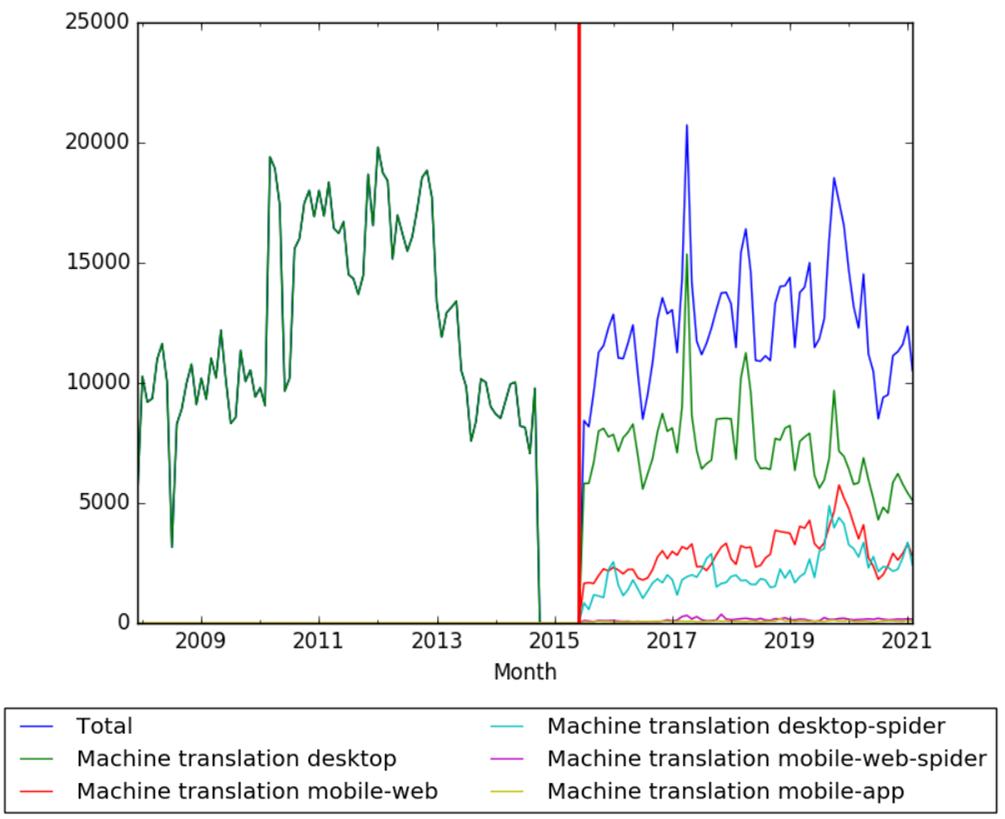Difference between revisions of "Timeline of machine translation"
(Created page with "{{Attribute English Wikipedia|original-exists=yes}} {{Orphan|date=October 2015}} This is a timeline of machine translation. For a more detailed qualitative account, see...") |
|||
| (6 intermediate revisions by 2 users not shown) | |||
| Line 1: | Line 1: | ||
{{Attribute English Wikipedia|original-exists=yes}} | {{Attribute English Wikipedia|original-exists=yes}} | ||
| − | + | This is a timeline of [[wikipedia:machine translation|machine translation]]. For a more detailed qualitative account, see the [[wikipedia:history of machine translation|history of machine translation]] page. | |
| − | |||
==Timeline== | ==Timeline== | ||
| Line 10: | Line 9: | ||
! Year !! Month and date (if available) !! Event type !! Event | ! Year !! Month and date (if available) !! Event type !! Event | ||
|- | |- | ||
| − | | 1924 || February || Proposal || The first known machine translation proposal was made in [[Estonia]] and involved a typewriter-translator. | + | | 1924 || February || Proposal || The first known machine translation proposal was made in [[wikipedia:Estonia|Estonia]] and involved a typewriter-translator. |
|- | |- | ||
| − | | 1933 || July 5 || Proposal || [[Georges Artsrouni]] patents a general-purpose device with many potential applications in [[France]]. He seems to have been working on the device since 1929.<ref name=twoprecursors>{{cite web|url=http://www.hutchinsweb.me.uk/IJT-2004.pdf|title = Two precursors of machine translation|year = 2004|accessdate = February 1, 2014|last = Hutchins|first = John}}</ref> | + | | 1933 || July 5 || Proposal || [[wikipedia:Georges Artsrouni|Georges Artsrouni]] patents a general-purpose device with many potential applications in [[wikipedia:France|France]]. He seems to have been working on the device since 1929.<ref name=twoprecursors>{{cite web|url=http://www.hutchinsweb.me.uk/IJT-2004.pdf|title = Two precursors of machine translation|year = 2004|accessdate = February 1, 2014|last = Hutchins|first = John}}</ref> |
|- | |- | ||
| − | | 1933 || September 5 || Proposal || [[Peter Petrovich Troyanskii]] is awarded an author's certificate (patent) for a proposal to use a mechanized dictionary for translation between languages.<ref name=twoprecursors/><ref name=troyanskii>{{cite journal|last = Hutchins|first = John|last2 = Lovtskii|first2 = Evgenii|year = 2000|title = Petr Petrovich Troyanskii (1894-1950): A Forgotten Pioneer of Mechanical Translation|jstor = 40009018|journal = Machine Translation|publisher = Springer|volume = 15|issue = 3|pages=187–221}}</ref> | + | | 1933 || September 5 || Proposal || [[wikipedia:Peter Petrovich Troyanskii|Peter Petrovich Troyanskii]] is awarded an author's certificate (patent) for a proposal to use a mechanized dictionary for translation between languages.<ref name=twoprecursors/><ref name=troyanskii>{{cite journal|last = Hutchins|first = John|last2 = Lovtskii|first2 = Evgenii|year = 2000|title = Petr Petrovich Troyanskii (1894-1950): A Forgotten Pioneer of Mechanical Translation|jstor = 40009018|journal = Machine Translation|publisher = Springer|volume = 15|issue = 3|pages=187–221}}</ref> |
|- | |- | ||
| 1939-1944|| || Proposal || Troyanskii approaches the Academy of Sciences in Russia with his proposal for machine translation, seeking to work with linguists. Discussions continue till 1944, but not much comes out of it.<ref name=troyanskii/> | | 1939-1944|| || Proposal || Troyanskii approaches the Academy of Sciences in Russia with his proposal for machine translation, seeking to work with linguists. Discussions continue till 1944, but not much comes out of it.<ref name=troyanskii/> | ||
|- | |- | ||
| − | | 1949 || July || Proposal || [[Warren Weaver]], working for the [[Rockefeller Foundation]] in the United States, puts forward a proposal for machine translation based on [[information theory]], successes of [[cryptography|code breaking]] during the [[World War II|second world war]] and speculation about universal underlying principles of natural language.<ref>{{cite web|url=http://ourworld.compuserve.com/homepages/WJHutchins/Weaver49.htm|title=Weaver memorandum|date=March 1949|archiveurl=https://web.archive.org/web/20061005232830/http://ourworld.compuserve.com/homepages/WJHutchins/Weaver49.htm|archivedate=2006-10-05}}</ref> | + | | 1949 || July || Proposal || [[wikipedia:Warren Weaver|Warren Weaver]], working for the [[wikipedia:Rockefeller Foundation|Rockefeller Foundation]] in the United States, puts forward a proposal for machine translation based on [[wikipedia:information theory|information theory]], successes of [[wikipedia:cryptography|code breaking]] during the [[wikipedia:World War II|second world war]] and speculation about universal underlying principles of natural language.<ref>{{cite web|url=http://ourworld.compuserve.com/homepages/WJHutchins/Weaver49.htm|title=Weaver memorandum|date=March 1949|archiveurl=https://web.archive.org/web/20061005232830/http://ourworld.compuserve.com/homepages/WJHutchins/Weaver49.htm|archivedate=2006-10-05}}</ref> |
|- | |- | ||
| − | | 1954 || January 7 || Demonstration || The [[Georgetown-IBM experiment]], held at the IBM head office in [[New York City]] in the United States, offers the first public demonstration of machine translation. The system itself, however, is no more than what today would be called a "toy" system, having just 250 words and translating just 49 carefully selected Russian sentences into English — mainly in the field of [[chemistry]]. Nevertheless, it encourages the view that machine translation was imminent — and in particular stimulates the financing of the research, not just in the US but worldwide.<ref name=nutshell>{{cite web|author=Hutchins, J.|year=2005|url=http://www.hutchinsweb.me.uk/Nutshell-2005.pdf|title=The history of machine translation in a nutshell}}{{self-published source|date=December 2013}}</ref> | + | | 1954 || January 7 || Demonstration || The [[wikipedia:Georgetown-IBM experiment|Georgetown-IBM experiment]], held at the IBM head office in [[wikipedia:New York City|New York City]] in the United States, offers the first public demonstration of machine translation. The system itself, however, is no more than what today would be called a "toy" system, having just 250 words and translating just 49 carefully selected Russian sentences into English — mainly in the field of [[wikipedia:chemistry|chemistry]]. Nevertheless, it encourages the view that machine translation was imminent — and in particular stimulates the financing of the research, not just in the US but worldwide.<ref name=nutshell>{{cite web|author=Hutchins, J.|year=2005|url=http://www.hutchinsweb.me.uk/Nutshell-2005.pdf|title=The history of machine translation in a nutshell}}{{self-published source|date=December 2013}}</ref> |
|- | |- | ||
| − | | 1958-1960 || || Report || In 1958, linguist [[Yehoshua Bar-Hillel]] travels around the world visiting machine translation centers to better understand the work they were doing. In 1959, he writes up a report (intended primarily for the US government) pointing out some key difficulties with machine translation that he believed might doom the efforts then underway. An expanded version of the report is published in 1960 in the annual review journal ''Advances in Computers''.<ref>{{cite web|url=http://www.hutchinsweb.me.uk/Bar-Hillel-2000.pdf|title = Yehoshua Bar-Hillel: A Philosopher's Contribution to Machine Translation|last = Hutchins|first = John|year = 2000|accessdate = February 1, 2014}}</ref> His main argument was that existing methods offered no way of resolving semantic ambiguities whose resolution required having an understanding of the terms being used, such as the ambiguity arising from a single word having multiple meanings. | + | | 1958-1960 || || Report || In 1958, linguist [[wikipedia:Yehoshua Bar-Hillel|Yehoshua Bar-Hillel]] travels around the world visiting machine translation centers to better understand the work they were doing. In 1959, he writes up a report (intended primarily for the US government) pointing out some key difficulties with machine translation that he believed might doom the efforts then underway. An expanded version of the report is published in 1960 in the annual review journal ''Advances in Computers''.<ref>{{cite web|url=http://www.hutchinsweb.me.uk/Bar-Hillel-2000.pdf|title = Yehoshua Bar-Hillel: A Philosopher's Contribution to Machine Translation|last = Hutchins|first = John|year = 2000|accessdate = February 1, 2014}}</ref> His main argument was that existing methods offered no way of resolving semantic ambiguities whose resolution required having an understanding of the terms being used, such as the ambiguity arising from a single word having multiple meanings. |
|- | |- | ||
| − | | 1966 || || Report || [[ALPAC]] publishes a report commissioned by the United States government. The report concludes that machine translation is more expensive, less accurate and slower than human translation, and that despite the expenses, machine translation is not likely to reach the quality of a human translator in the near future. It recommends that tools be developed to aid translators — automatic dictionaries, for example — and that some research in computational linguistics should continue to be supported.<ref>{{cite web|url=http://www.nap.edu/openbook.php?record_id=9547|title = Languages and Machines: Computers in Translation and Linguistics|publisher = [[ALPAC]]|year = 1966|accessdate = February 1, 2014}}</ref><ref>{{cite web|url=http://www.hutchinsweb.me.uk/ALPAC-1996.pdf|title = ALPAC: the (in)famous report|last = Hutchins|first = John|year = 1996|accessdate = February 1, 2014}}</ref> The report causes a significant decline in government funding for machine translation in the US, and to a lesser extent in the UK and Russia. | + | | 1966 || || Report || [[wikipedia:ALPAC|ALPAC]] publishes a report commissioned by the United States government. The report concludes that machine translation is more expensive, less accurate and slower than human translation, and that despite the expenses, machine translation is not likely to reach the quality of a human translator in the near future. It recommends that tools be developed to aid translators — automatic dictionaries, for example — and that some research in computational linguistics should continue to be supported.<ref>{{cite web|url=http://www.nap.edu/openbook.php?record_id=9547|title = Languages and Machines: Computers in Translation and Linguistics|publisher = [[wikipedia:ALPAC|ALPAC]]|year = 1966|accessdate = February 1, 2014}}</ref><ref>{{cite web|url=http://www.hutchinsweb.me.uk/ALPAC-1996.pdf|title = ALPAC: the (in)famous report|last = Hutchins|first = John|year = 1996|accessdate = February 1, 2014}}</ref> The report causes a significant decline in government funding for machine translation in the US, and to a lesser extent in the UK and Russia. |
|- | |- | ||
| − | | 1968 || || Creation of organization || [[SYSTRAN]] is started by [[Peter Toma]].{{citation needed|date=February 2014}} | + | | 1968 || || Creation of organization || [[wikipedia:SYSTRAN|SYSTRAN]] is started by [[wikipedia:Peter Toma|Peter Toma]].{{citation needed|date=February 2014}} |
|- | |- | ||
| − | | 1970 || || Creation of organization || [[Logos]] is started by Bernard Scott.{{citation needed|date=February 2014}} | + | | 1970 || || Creation of organization || [[wikipedia:Logos|Logos]] is started by Bernard Scott.{{citation needed|date=February 2014}} |
|- | |- | ||
| − | | 1977 || || Deployment || The [[METEO System]], developed at the [[Université de Montréal]], is installed in [[Canada]] to translate weather forecasts from English to French, and is translating close to 80,000 words per day or 30 million words per year until it is replaced by a competitor's system on 30 September 2001.<ref>{{cite web|url=http://www.citt.gc.ca/procure/determin/pr2b029_e.asp#P90_10741|title=PROCUREMENT PROCESS|work=Canadian International Trade Tribunal|date=30 July 2002|accessdate=2007-02-10|archiveurl=https://web.archive.org/web/20110706181412/http://www.citt.gc.ca/procure/determin/pr2b029_e.asp#P90_10741|archivedate=2011-07-06}}</ref> | + | | 1977 || || Deployment || The [[wikipedia:METEO System|METEO System]], developed at the [[wikipedia:Université de Montréal|Université de Montréal]], is installed in [[wikipedia:Canada|Canada]] to translate weather forecasts from English to French, and is translating close to 80,000 words per day or 30 million words per year until it is replaced by a competitor's system on 30 September 2001.<ref>{{cite web|url=http://www.citt.gc.ca/procure/determin/pr2b029_e.asp#P90_10741|title=PROCUREMENT PROCESS|work=Canadian International Trade Tribunal|date=30 July 2002|accessdate=2007-02-10|archiveurl=https://web.archive.org/web/20110706181412/http://www.citt.gc.ca/procure/determin/pr2b029_e.asp#P90_10741|archivedate=2011-07-06}}</ref> |
|- | |- | ||
| − | | 1984 || || Proposal || [[Makoto Nagao]] proposes [[example-based machine translation]]. The idea is to break down sentences into phrases (subsentential units) and learn the translations of those phrases using a corpus of examples. With enough phrases known, new sentences that combine existing phrases in a novel manner can be translated.<ref>{{Cite book |author= [[Makoto Nagao]] |title= Artificial and Human Intelligence |chapter= A framework of a mechanical translation between Japanese and English by analogy principle |editor= A. Elithorn and R. Banerji |year= 1984 |publisher= [[Elsevier Science Publishers]] |url= http://www.mt-archive.info/Nagao-1984.pdf }}</ref> | + | | 1984 || || Proposal || [[wikipedia:Makoto Nagao|Makoto Nagao]] proposes [[wikipedia:example-based machine translation|example-based machine translation]]. The idea is to break down sentences into phrases (subsentential units) and learn the translations of those phrases using a corpus of examples. With enough phrases known, new sentences that combine existing phrases in a novel manner can be translated.<ref>{{Cite book |author= [[wikipedia:Makoto Nagao|Makoto Nagao]] |title= Artificial and Human Intelligence |chapter= A framework of a mechanical translation between Japanese and English by analogy principle |editor= A. Elithorn and R. Banerji |year= 1984 |publisher= [[wikipedia:Elsevier Science Publishers|Elsevier Science Publishers]] |url= http://www.mt-archive.info/Nagao-1984.pdf }}</ref> |
|- | |- | ||
| − | | 1997 || || Web translation tool || The world's first web translation tool, [[Yahoo! Babel Fish|Babel Fish]], is launched as a subdomain of the [[AltaVista]] search engine. The tool is created by [[Systran]] in collaboration with [[Digital Equipment Corporation]].<ref>{{cite web|title=Real-Time Machine Translation on the Internet |url=http://www.infotektur.com/demos/babelfish/en.html |date=May 1998 |publisher=Infotektur.com |accessdate=2012-07-18}}</ref><ref>{{cite web|last=Edge |first=Business |url=http://www.businessedge.ca/archives/article.cfm/babelfish-on-the-move-3074/ |title=BabelFish on the move - Business Edge News Magazine Archives |publisher=Businessedge.ca |date=2003-05-15 |accessdate=2012-09-20}}</ref> | + | | 1997 || || Web translation tool || The world's first web translation tool, [[wikipedia:Yahoo! Babel Fish|Babel Fish]], is launched as a subdomain of the [[wikipedia:AltaVista|AltaVista]] search engine. The tool is created by [[wikipedia:Systran|Systran]] in collaboration with [[wikipedia:Digital Equipment Corporation|Digital Equipment Corporation]].<ref>{{cite web|title=Real-Time Machine Translation on the Internet |url=http://www.infotektur.com/demos/babelfish/en.html |date=May 1998 |publisher=Infotektur.com |accessdate=2012-07-18}}</ref><ref>{{cite web|last=Edge |first=Business |url=http://www.businessedge.ca/archives/article.cfm/babelfish-on-the-move-3074/ |title=BabelFish on the move - Business Edge News Magazine Archives |publisher=Businessedge.ca |date=2003-05-15 |accessdate=2012-09-20}}</ref> |
|- | |- | ||
| − | | 2006 || April || Web translation tool || [[Google Translate]] is launched.<ref>{{cite web|url=https://www.google.com/about/company/history/#2006|title = Our history in depth (2006)|publisher = [[Google]]|accessdate = February 2, 2014}}</ref> | + | | 2006 || April || Web translation tool || [[wikipedia:Google Translate|Google Translate]] is launched.<ref>{{cite web|url=https://www.google.com/about/company/history/#2006|title = Our history in depth (2006)|publisher = [[wikipedia:Google|Google]]|accessdate = February 2, 2014}}</ref> |
|} | |} | ||
| + | |||
| + | == Numerical and visual data == | ||
| + | |||
| + | === Google Scholar === | ||
| + | |||
| + | The following table summarizes per-year mentions on Google Scholar as of October 19, 2021. | ||
| + | |||
| + | {| class="sortable wikitable" | ||
| + | ! Year | ||
| + | ! "machine translation" | ||
| + | |- | ||
| + | | 1950 || 0 | ||
| + | |- | ||
| + | | 1955 || 64 | ||
| + | |- | ||
| + | | 1960 || 200 | ||
| + | |- | ||
| + | | 1965 || 272 | ||
| + | |- | ||
| + | | 1970 || 180 | ||
| + | |- | ||
| + | | 1975 || 135 | ||
| + | |- | ||
| + | | 1980 || 174 | ||
| + | |- | ||
| + | | 1985 || 373 | ||
| + | |- | ||
| + | | 1990 || 856 | ||
| + | |- | ||
| + | | 1995 || 1,100 | ||
| + | |- | ||
| + | | 2000 || 1,880 | ||
| + | |- | ||
| + | | 2005 || 3,570 | ||
| + | |- | ||
| + | | 2010 || 5,820 | ||
| + | |- | ||
| + | | 2015 || 7,800 | ||
| + | |- | ||
| + | | 2020 || 24,300 | ||
| + | |- | ||
| + | |} | ||
| + | |||
| + | [[File:Machine translation gsch.png|thumb|center|700px]] | ||
| + | |||
| + | === Google Trends === | ||
| + | |||
| + | The comparative chart below shows {{w|Google Trends}} data Machine translation (Field of study) and Machine translation (Search term), from January 2004 to March 2021, when the screenshot was taken. Interest is also ranked by country and displayed on world map.<ref>{{cite web |title=Machine translation |url=https://trends.google.com/trends/explore?date=all&q=%2Fm%2F050ls,Machine%20translation |website=Google Trends |access-date=11 March 2021}}</ref> | ||
| + | |||
| + | [[File:Machine translation gt.png|thumb|center|600px]] | ||
| + | |||
| + | === Google Ngram Viewer === | ||
| + | |||
| + | The chart below shows {{w|Google Ngram Viewer}} data for Machine translation, from 1900 to 2019.<ref>{{cite web |title=Machine translation |url=https://books.google.com/ngrams/graph?content=Machine+translation&year_start=1900&year_end=2019&corpus=26&smoothing=3&case_insensitive=true |website=books.google.com |access-date=11 March 2021 |language=en}}</ref> | ||
| + | |||
| + | [[File:Machine translation ngram.png|thumb|center|700px]] | ||
| + | |||
| + | === Wikipedia Views === | ||
| + | |||
| + | The chart below shows pageviews of the English Wikipedia article {{w|Machine translation}}, on desktop from December 2007, and on mobile-web, desktop-spider, mobile-web-spider and mobile app, from July 2015; to February 2021.<ref>{{cite web |title=Machine translation |url=https://wikipediaviews.org/displayviewsformultiplemonths.php?page=Machine+translation&allmonths=allmonths&language=en&drilldown=all |website=wikipediaviews.org |access-date=11 March 2021}}</ref> | ||
| + | |||
| + | [[File:Machine translation wv.png|thumb|center|400px]] | ||
| + | |||
==See also== | ==See also== | ||
| − | * [[Timeline of machine learning]] | + | * [[wikipedia:Timeline of machine learning|Timeline of machine learning]] |
==References== | ==References== | ||
{{reflist}} | {{reflist}} | ||
| − | [[Category:Machine translation]] | + | [[wikipedia:Category:Machine translation|Category:Machine translation]] |
| − | [[Category:Computing timelines|Machine translation]] | + | [[wikipedia:Category:Computing timelines|Machine translation]] |
Latest revision as of 19:58, 20 March 2024
This is a timeline of machine translation. For a more detailed qualitative account, see the history of machine translation page.
Contents
Timeline
| Year | Month and date (if available) | Event type | Event |
|---|---|---|---|
| 1924 | February | Proposal | The first known machine translation proposal was made in Estonia and involved a typewriter-translator. |
| 1933 | July 5 | Proposal | Georges Artsrouni patents a general-purpose device with many potential applications in France. He seems to have been working on the device since 1929.[1] |
| 1933 | September 5 | Proposal | Peter Petrovich Troyanskii is awarded an author's certificate (patent) for a proposal to use a mechanized dictionary for translation between languages.[1][2] |
| 1939-1944 | Proposal | Troyanskii approaches the Academy of Sciences in Russia with his proposal for machine translation, seeking to work with linguists. Discussions continue till 1944, but not much comes out of it.[2] | |
| 1949 | July | Proposal | Warren Weaver, working for the Rockefeller Foundation in the United States, puts forward a proposal for machine translation based on information theory, successes of code breaking during the second world war and speculation about universal underlying principles of natural language.[3] |
| 1954 | January 7 | Demonstration | The Georgetown-IBM experiment, held at the IBM head office in New York City in the United States, offers the first public demonstration of machine translation. The system itself, however, is no more than what today would be called a "toy" system, having just 250 words and translating just 49 carefully selected Russian sentences into English — mainly in the field of chemistry. Nevertheless, it encourages the view that machine translation was imminent — and in particular stimulates the financing of the research, not just in the US but worldwide.[4] |
| 1958-1960 | Report | In 1958, linguist Yehoshua Bar-Hillel travels around the world visiting machine translation centers to better understand the work they were doing. In 1959, he writes up a report (intended primarily for the US government) pointing out some key difficulties with machine translation that he believed might doom the efforts then underway. An expanded version of the report is published in 1960 in the annual review journal Advances in Computers.[5] His main argument was that existing methods offered no way of resolving semantic ambiguities whose resolution required having an understanding of the terms being used, such as the ambiguity arising from a single word having multiple meanings. | |
| 1966 | Report | ALPAC publishes a report commissioned by the United States government. The report concludes that machine translation is more expensive, less accurate and slower than human translation, and that despite the expenses, machine translation is not likely to reach the quality of a human translator in the near future. It recommends that tools be developed to aid translators — automatic dictionaries, for example — and that some research in computational linguistics should continue to be supported.[6][7] The report causes a significant decline in government funding for machine translation in the US, and to a lesser extent in the UK and Russia. | |
| 1968 | Creation of organization | SYSTRAN is started by Peter Toma.Template:Fix/category[citation needed] | |
| 1970 | Creation of organization | Logos is started by Bernard Scott.Template:Fix/category[citation needed] | |
| 1977 | Deployment | The METEO System, developed at the Université de Montréal, is installed in Canada to translate weather forecasts from English to French, and is translating close to 80,000 words per day or 30 million words per year until it is replaced by a competitor's system on 30 September 2001.[8] | |
| 1984 | Proposal | Makoto Nagao proposes example-based machine translation. The idea is to break down sentences into phrases (subsentential units) and learn the translations of those phrases using a corpus of examples. With enough phrases known, new sentences that combine existing phrases in a novel manner can be translated.[9] | |
| 1997 | Web translation tool | The world's first web translation tool, Babel Fish, is launched as a subdomain of the AltaVista search engine. The tool is created by Systran in collaboration with Digital Equipment Corporation.[10][11] | |
| 2006 | April | Web translation tool | Google Translate is launched.[12] |
Numerical and visual data
Google Scholar
The following table summarizes per-year mentions on Google Scholar as of October 19, 2021.
| Year | "machine translation" |
|---|---|
| 1950 | 0 |
| 1955 | 64 |
| 1960 | 200 |
| 1965 | 272 |
| 1970 | 180 |
| 1975 | 135 |
| 1980 | 174 |
| 1985 | 373 |
| 1990 | 856 |
| 1995 | 1,100 |
| 2000 | 1,880 |
| 2005 | 3,570 |
| 2010 | 5,820 |
| 2015 | 7,800 |
| 2020 | 24,300 |
Google Trends
The comparative chart below shows Google Trends data Machine translation (Field of study) and Machine translation (Search term), from January 2004 to March 2021, when the screenshot was taken. Interest is also ranked by country and displayed on world map.[13]
Google Ngram Viewer
The chart below shows Google Ngram Viewer data for Machine translation, from 1900 to 2019.[14]
Wikipedia Views
The chart below shows pageviews of the English Wikipedia article Machine translation, on desktop from December 2007, and on mobile-web, desktop-spider, mobile-web-spider and mobile app, from July 2015; to February 2021.[15]
See also
References
- ↑ 1.0 1.1 Hutchins, John (2004). "Two precursors of machine translation" (PDF). Retrieved February 1, 2014.
- ↑ 2.0 2.1 Hutchins, John; Lovtskii, Evgenii (2000). "Petr Petrovich Troyanskii (1894-1950): A Forgotten Pioneer of Mechanical Translation". Machine Translation. Springer. 15 (3): 187–221. JSTOR 40009018.
- ↑ "Weaver memorandum". March 1949. Archived from the original on 2006-10-05.
- ↑ Hutchins, J. (2005). "The history of machine translation in a nutshell" (PDF).Template:Fix/category[self-published source]
- ↑ Hutchins, John (2000). "Yehoshua Bar-Hillel: A Philosopher's Contribution to Machine Translation" (PDF). Retrieved February 1, 2014.
- ↑ "Languages and Machines: Computers in Translation and Linguistics". ALPAC. 1966. Retrieved February 1, 2014.
- ↑ Hutchins, John (1996). "ALPAC: the (in)famous report" (PDF). Retrieved February 1, 2014.
- ↑ "PROCUREMENT PROCESS". Canadian International Trade Tribunal. 30 July 2002. Archived from the original on 2011-07-06. Retrieved 2007-02-10.
- ↑ Makoto Nagao (1984). "A framework of a mechanical translation between Japanese and English by analogy principle". In A. Elithorn and R. Banerji. Artificial and Human Intelligence (PDF). Elsevier Science Publishers.
- ↑ "Real-Time Machine Translation on the Internet". Infotektur.com. May 1998. Retrieved 2012-07-18.
- ↑ Edge, Business (2003-05-15). "BabelFish on the move - Business Edge News Magazine Archives". Businessedge.ca. Retrieved 2012-09-20.
- ↑ "Our history in depth (2006)". Google. Retrieved February 2, 2014.
- ↑ "Machine translation". Google Trends. Retrieved 11 March 2021.
- ↑ "Machine translation". books.google.com. Retrieved 11 March 2021.
- ↑ "Machine translation". wikipediaviews.org. Retrieved 11 March 2021.



